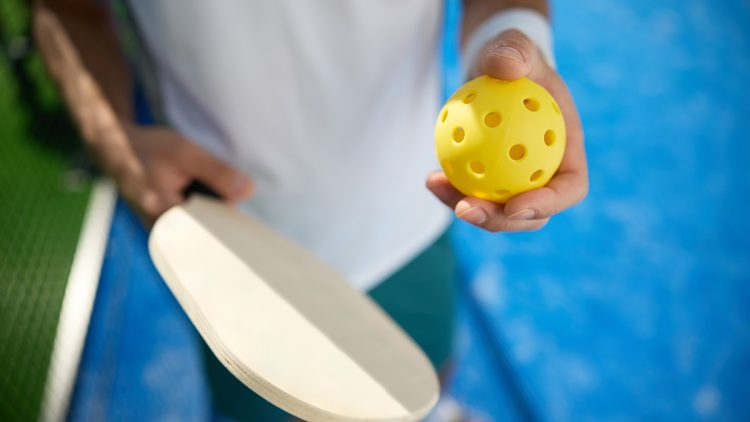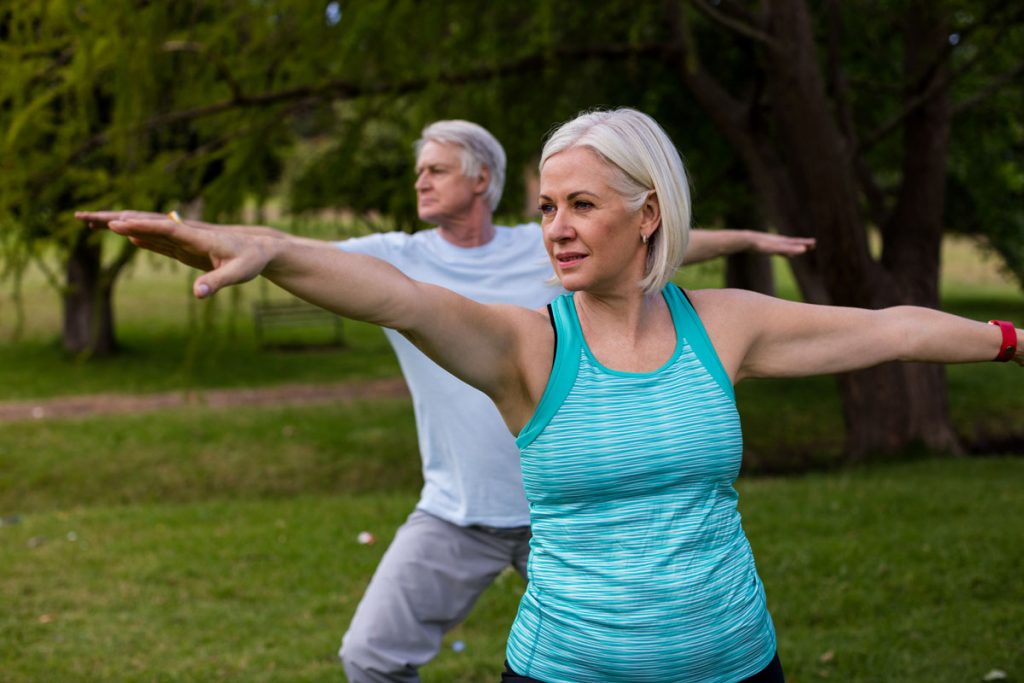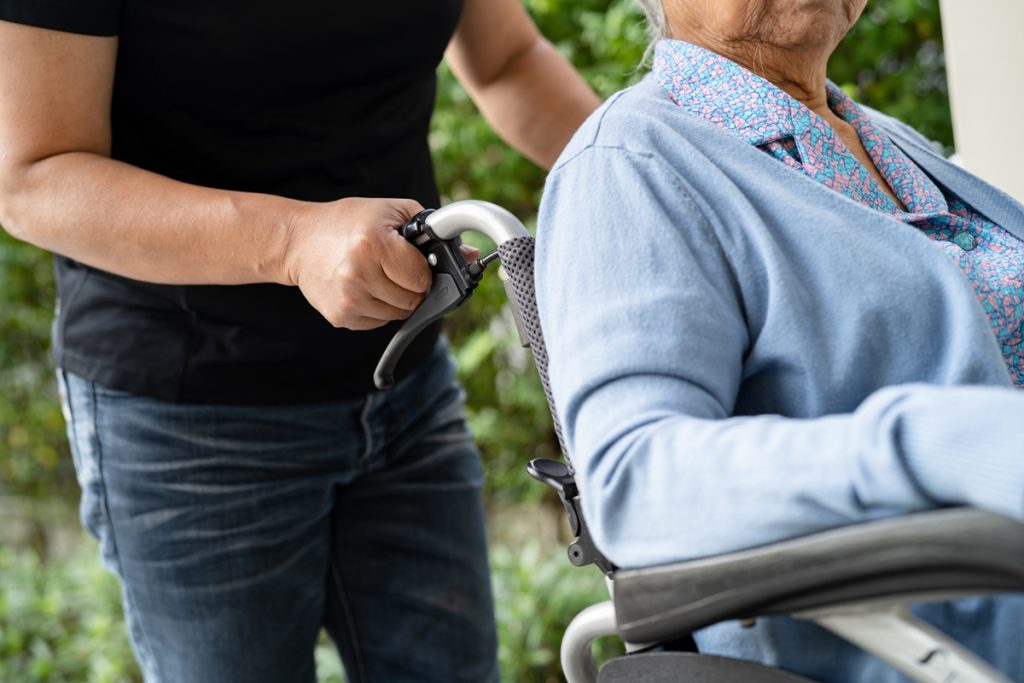What Are the rules of pickleball?
Read on to learn more about how to play Pickleball!
1. Court Setup and Equipment
- Court Size: 20′ x 44′, the same size for both singles and doubles.
- Net Height: 36 inches at the sidelines and 34 inches at the center.
- Paddle and Ball: Played with a solid paddle (wood, composite, or graphite) and a perforated plastic ball (similar to a wiffle ball).
2. Serving
- Underhand Serve: The serve must be made underhand with the paddle below the waist and contact with the ball made below the server’s waist.
- Diagonal Direction: Serve diagonally to the opposite service box.
- One Attempt: Only one serve attempt is allowed, except in the case of a “let” (when the ball touches the net but lands in the correct service box).
- Both Feet Behind the Line: At least one foot must be behind the baseline during the serve.
3. The Double-Bounce Rule
- After the serve, the receiving team must let the ball bounce once before returning it. Similarly, the serving team must let the return bounce once before playing it. After these two bounces, players may volley (hit the ball without letting it bounce) or play off the bounce.
4. Non-Volley Zone (The Kitchen)
- The area within 7 feet on either side of the net is the non-volley zone, commonly called the “kitchen.”
- Players cannot volley the ball (hit it out of the air) while standing inside the kitchen or touching the kitchen line.
- Players may enter the kitchen to play a ball that has bounced but must exit before volleying the ball again.
5. Scoring
- Points are Only Scored by the Serving Team: A team scores a point only if they win a rally while serving.
- First to 11 Points: Games are typically played to 11 points, but a team must win by at least 2 points. Some tournaments or games may go to 15 or 21 points.
- Switching Servers: In doubles, both players on a team serve before the serve is turned over to the opposing team, except at the start of the game, where the first server gets only one serve.
- Side-Out: When the serving team loses a rally, it’s called a “side-out,” and the opposing team gets the chance to serve.
6. Faults
Faults result in the loss of serve or a point, and they occur when:
- The ball is hit out of bounds.
- The ball does not clear the net.
- The ball is volleyed from within the non-volley zone (kitchen).
- The ball bounces twice before it is returned.
- The ball is struck more than once by the same team before going over the net.
7. Doubles Play
- Each team member serves and rallies until both players have had a chance to serve (except for the first service of the game).
- When the serving team wins a point, the server switches sides with their partner, and the server continues to serve.
8. Singles Play
- The server serves from the right side when their score is even and from the left when their score is odd.
- Other than that, the rules are the same as for doubles.
By mastering these rules, players can enjoy the game of pickleball whether in casual settings or competitive matches!
Pickleball is often considered an excellent sport for seniors for several reasons:
1. Low Impact:
- Joint-Friendly: Pickleball is generally easy on the joints compared to high-impact sports like tennis or running. The smaller court and slower pace reduce stress on the knees, hips, and other joints.
2. Moderate Exercise:
- Cardiovascular Benefits: The game provides good cardiovascular exercise, helping to maintain heart health and improve overall fitness.
- Muscle Strength: It helps build and maintain muscle strength, particularly in the legs, arms, and core.
3. Social Interaction:
- Community Aspect: Pickleball is often played in a social, friendly environment. It provides opportunities for socializing and meeting new people, which can be beneficial for mental health and well-being.
4. Easy to Learn:
- Simple Rules: The game is relatively easy to pick up, with simple rules and a straightforward scoring system. This makes it accessible for beginners and those who may not have played sports before.
5. Adaptable:
- Adjustable Intensity: Players can adjust the intensity of the game based on their fitness level. It can be played at a leisurely pace or more competitively, depending on the players’ preferences and abilities.
6. Cognitive Benefits:
- Mental Stimulation: The game involves strategy, quick thinking, and hand-eye coordination, which can help keep the mind sharp and improve cognitive function.
7. Flexibility:
- Indoor and Outdoor: Pickleball can be played both indoors and outdoors, allowing for year-round play regardless of weather conditions.
8. Safety:
- Reduced Risk of Injury: Due to its lower impact nature and smaller court size, the risk of injury is relatively low compared to more intense sports.
Additional Tips for Seniors Playing Pickleball:
- Warm-Up: Proper warm-up and stretching are important to prevent injuries and improve flexibility.
- Proper Gear: Use supportive footwear and consider using a paddle with a comfortable grip to minimize strain on the hands and wrists.
- Hydration: Stay hydrated and take breaks as needed, especially in hot weather.
- Consult a Doctor: If you have any health concerns or conditions, consult with a healthcare provider before starting any new sport or exercise routine.
Overall, pickleball offers a fun, engaging, and health-promoting activity that can be enjoyed by seniors of various fitness levels.
How To Play Pickleball
Pickleball is a fun and accessible sport that combines elements of tennis, badminton, and table tennis. It’s played with a paddle and a plastic ball on a court similar to a badminton court. Here’s a basic guide on how to play pickleball:
1. Equipment:
- Paddle: A solid, perforated paddle, usually made of composite materials or wood.
- Ball: A lightweight plastic ball with holes, similar to a wiffle ball.
- Net: A net set at a height of 34 inches in the center and 36 inches at the sidelines.
- Court: A rectangular court measuring 20 feet by 44 feet for both singles and doubles, divided by a net.
2. Court Layout:
- Service Area: The court is divided into two halves by the net. Each half has a service area, which is the area where serves are made.
- Non-Volley Zone (Kitchen): A 7-foot area on either side of the net where players cannot volley (hit the ball before it bounces).
3. Basic Rules:
- Objective: The objective is to score points by hitting the ball over the net and into the opponent’s side of the court, where it must bounce or be returned in play.
- Serving:
- The serve must be made underhand and diagonally into the opponent’s service area.
- The server must stand behind the baseline and keep one foot behind the line.
- The serve must clear the non-volley zone.
- Double Bounce Rule: After the serve, each side must let the ball bounce once before volleying it (hitting it in the air).
- Scoring:
- Games are typically played to 11 points, but a team must win by at least 2 points.
- Only the serving side can score points.
- In doubles, each player on the serving side gets a chance to serve before the serve changes sides.
- Faults:
- A fault occurs if the ball lands outside the court, does not clear the net, or is hit into the non-volley zone on a volley.
- Stepping into the non-volley zone and volleying the ball is also a fault.
4. Playing the Game:
- Serving: The game starts with one player serving from the right side of their court. After each point, the server switches sides.
- Rally: Players hit the ball back and forth over the net. Each side must return the ball before it bounces twice on their side.
- Volleys and Groundstrokes: Players can hit the ball either on the bounce (groundstroke) or in the air (volley). However, volleys cannot be made from within the non-volley zone.
- Switching Sides: In doubles, after scoring, the server switches sides with their partner, and the receiving team also switches sides.
5. Strategy:
- Placement: Aim for open spaces on the opponent’s side of the court to make it harder for them to return the ball.
- Positioning: Stay near the baseline when receiving serve and move towards the net as the rally progresses. For doubles, communicate and cover the court effectively with your partner.
- Soft Shots: Use dinks (soft, controlled shots) to drop the ball into the non-volley zone, making it challenging for opponents to attack.
6. Scoring System:
- Traditional Scoring: Points can only be scored by the serving side. The server continues to serve until a fault occurs.
- No-Volley Zone: When serving, the ball must clear the no-volley zone (kitchen) to be considered a legal serve.
7. Etiquette:
- Respect: Show respect for your opponents and teammates, and maintain good sportsmanship throughout the game.
- Communication: In doubles, communicate with your partner about positioning and strategy.
8. Practice and Enjoyment:
- Learn and Practice: Take time to practice basic shots, serving, and court positioning. Many communities offer beginner clinics and practice sessions.
- Have Fun: Enjoy the game and the social aspects of pickleball. It’s designed to be accessible and enjoyable for players of all skill levels.
Pickleball is a great sport that emphasizes fun, fitness, and friendly competition. With these basics, you can start playing and enjoying the game!
Related Posts




